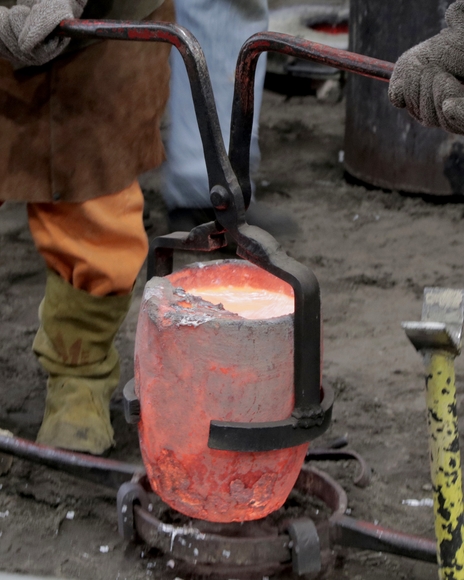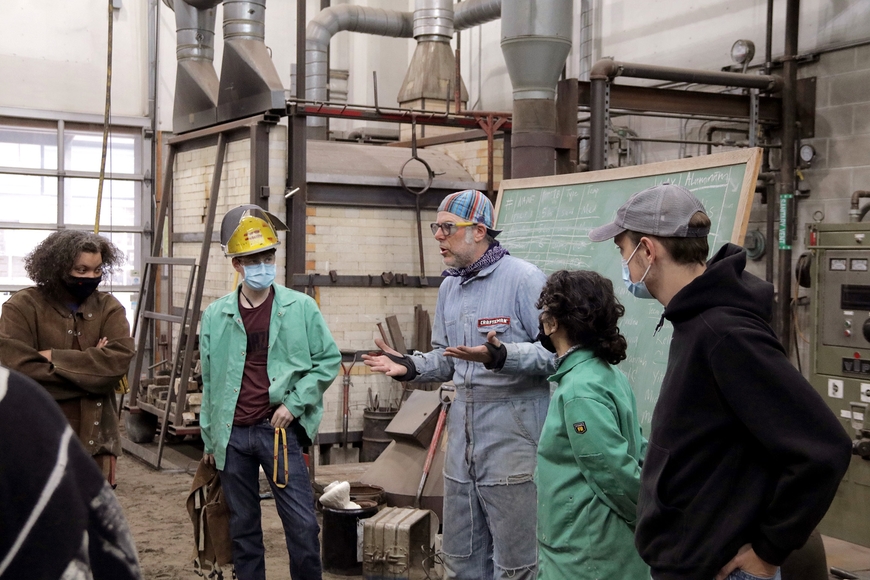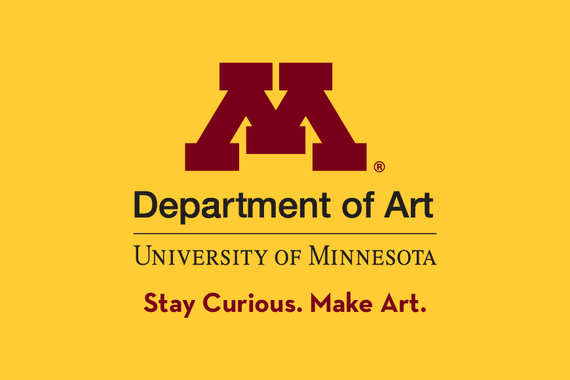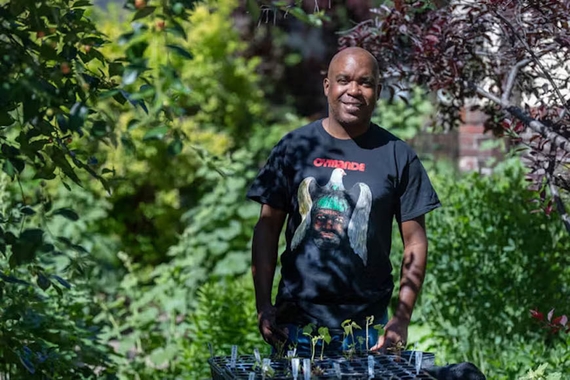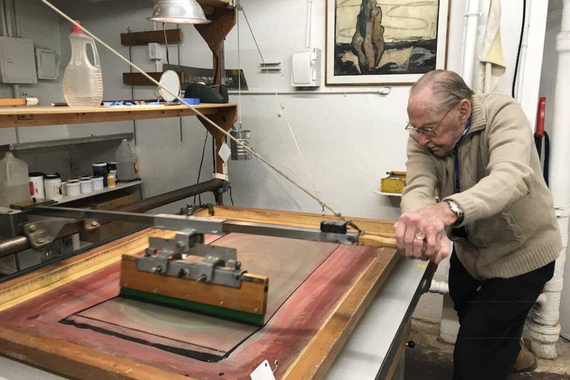Forging Ahead
It’s a chilly, rainy April day outside, the kind that is all too common in Minnesota, but the students inside the foundry at the Regis Center for Art aren’t bundled up against the cold. Quite the opposite: clad head to toe in thick leather aprons, chaps, and hardhats, the students in Assistant Professor Rotem Tamir’s Foundry and Metal Sculpture class are about to lift a 1450° pot of molten aluminum out of the furnace. Things are about to get hot.
The class’s molds are lined up on the floor nearby — at the moment just a series of blocks and buckets with holes in the top, concealing the shape of what soon will become artwork. The crucible emerges, glowing orange from the heat, and the students move into place. A delicate, well-choreographed dance is about to begin.
It’s a process that takes teamwork. As two students balance and tilt the liquid metal into a line of molds, another stands in front and scrapes excess from the mouth of the crucible, and a fourth moves the pot up and down with a 3-ton bridge crane, all under the watchful guidance of Tamir, TA Stephanie Lindquist (MFA ‘22), and Sculpture/Foundry Tech Paul Linden.
“The students really need to work together very well, in a very synergistic way,” says Tamir. “So they learn a lot about how to communicate and how to respond. In this course, you’re basically learning how to work with people. Most of the things that we are doing here, you can’t do alone.”
“The first pour is the scariest,” says one student, a senior Ojibwe Language major, who is at a workbench cleaning up a bronze dragon sculpture from an earlier pour. “After that, it’s not so bad.”
Another senior, graduating soon with a BA in Art, shows off a bronze Yoda mask he has made, part of a series the artist is creating about childhood objects. An aluminum cast of a lightsaber, still in its mold, sits nearby on the table between a scattered assortment of cleaning and grinding tools. Ceramics classes convinced him to major in Art, but Foundry has been his favorite, he says. “I’m having a blast.”

That kind of interdisciplinary approach is exactly what the Department has been working to develop, says Associate Professor Chris Larson, who also teaches Foundry and Metal Sculpture. “Foundry is another tool, another process,” he says, “and the intention was to bring it into the larger department.”
At a time when so much of the learning experience had to move online, Larson, Tamir, and Linden worked to provide students with as much opportunity for hands-on experience as possible. “During the pandemic, we offered space for intro students to each have an experience in the foundry,” says Larson. “We made 75 scratch molds and distributed them to our intro classes, so that they could have an experience in there. We opened it up to grad students, we opened it up to faculty, and we started a sculpture club. So it was really trying to build a community into the whole space.”

And that sense of community is palpable, mixed in amongst the smell of ground metal wafting through the air. You can hear it in the laughter coming from the workbenches, where Tamir and some students are talking about the solid aluminum sneaker one of them is working on. While they’re getting suited up to pour, another student strikes a pose, flexing for the cameraphones that come out to capture the moment. Once the pour begins, though, they come together even more — serious about getting the job done smoothly and safely.
Named in honor of Professor & Scholar Emeritus Wayne Potratz, who taught here for 44 years and oversaw 50 community iron pours, the Regis Center foundry is home to induction furnaces for bronze and iron, two cupolettes, gas-fired crucible furnaces, a burn-out/melt-out kiln, and a ceramic shell molding studio. It also provides facilities for standard investment, chemically-bonded sand, green sand, and centrifugally cast molds. Today the students are pouring aluminum; the week after will be bronze. And in the future Larson hopes to be up and running with stainless steel and iron pours as well.
Back on the foundry floor, the students are moving methodically down the line of molds, pouring the silver liquid until it pools up at the top of each container. At the end of the line, they pour the remainder of the aluminum into open trays to create ingots, which will cool, harden, and be melted down at some point again for a future pour. “There’s metal in here that’s been here for 45 years,” says Linden, who was an Art major here once himself. “It just continues to get recycled.”

That sense of tradition goes back even further, though. “It’s a very ancient technique,” says Tamir, one that dates back thousands of years. And now, here, it is moving forward as well, inspiring students from all backgrounds and interests to learn what this method – along with hard work and cooperation – can accomplish.
“This is the very fun part: pouring,” Tamir explains. “But this is not the end; this is not the result yet. This is just 50%.” Next comes grinding and cleaning and polishing — if, that is, what comes out of your mold is successful at all. The students will find out soon enough.
“It’s a lot of process,” she says, “and you need to believe in the process.”

